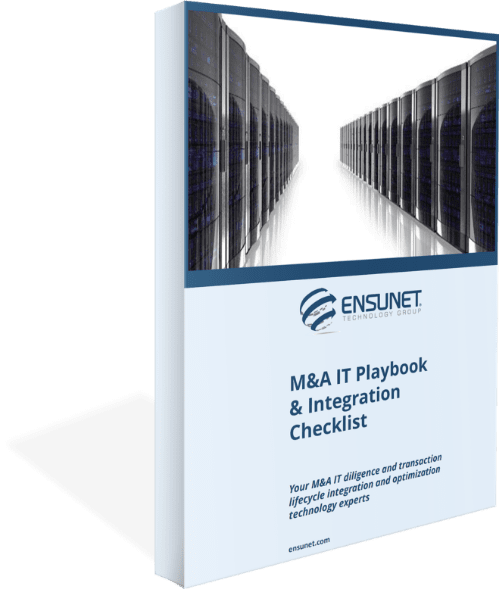M&A IT Playbook & Integration Checklist
Free M&A IT Playbook & Integration Checklist

M&A IT Playbook & Integration Checklist


“In 20 years, it will be hard to distinguish between a technology company and a non-technology company.”
That’s a bold prediction. Know who taught it to Ensunet?
It was Fred Hencke. He’s a transformational management and HR consultant. And he knows what he’s talking about: He has a background in software engineering and mathematics, and today is a Senior Vice President at Segal, a privately-owned benefits, human capital, communications, technology, insurance brokerage and investment consulting firm with more than 1,000 employees throughout the U.S. and Canada.
Here at Ensunet, we specialize in enterprise IT that lives at the bleeding edge of mergers and acquisitions. And Fred is working at the bleeding edge of mergers and acquisitions generally. He’s a true thought leader, and so we recently sat down with him to get his insights on one of the hottest hot-button issues in the M&A world: the ascension of environmental, social, and governance or ESG factors as they pertain to the valuation of companies on the block.
ESG—and its closely-related partner acronym, DE&I, for diversity, equity, and inclusion—are no longer just buzzwords or lip-service checkbox items. They’re growing ever-more important when sizing up acquisition targets for value and fit within the expanded enterprise portfolio.
Here, then, are some of the insights that Fred shared with us in our chat.
It all starts at the top
Who does the C-suite answer to? The board. Who does the board answer to? The investors. More and more, attention to ESG issues is being paid at the board and executive levels, and by the investors they both serve.
At private and public companies alike, the board and the C-suite are concerned about their reputation in the market. What are they, as companies, doing to address these issues? How are they demonstrably moving the ball forward?
The investors are peering through the same lens. Yes, there’s a lot of social conscience here, but there’s also a generous serving of good old-fashioned capitalism in the mix: Investors know that if their company’s reputation takes a hit because they’re failing to keep up with these trends, then customers, and even suppliers, can peel away from that company, creating a direct and negative impact on its performance.
Case in point: Remember the (dare we mention them by name?) Washington Redskins NFL team? They were under tremendous pressure to adapt; and Covid, as Fred notes, “put a magnifying glass” on the situation. Again, it’s the intersection of conscience and finance: Core values, not to mention millions of dollars, were at stake.
And what about the board of an acquisition target? They’d better live up to these values, too. If they don’t, that’s a red flag. What’s the diversity of the board itself? What about their advisory board? Could this require some insulation, or culture-change, in order to properly consummate the deal? Or could it derail it entirely? Again, Fred’s a good person to talk to about this; he serves on a social-justice task force.
The workforce pipeline
Issues of social justice may start at the board room, but they permeate all the way down to the break room. A company needs a pipeline of diverse candidates. It requires a mentoring and matchmaking system; this is the first place that investors, and employees, look.
A company needs to ask: What sources is it using to ensure the diversity of its candidates? Sure, the leading job boards have filters for this, but they don’t specialize in it; to succeed, you need actual specialized sources. This is important, because, generally, candidates don’t self-identify as minority on job boards, which limits your ability to find them, right there.
Banking and supply chain
Here’s another often-overlooked opportunity for making an impact: Banking. Where does that company make its investments? Minority-owned banks are closest to under-served communities; investing in them means directing capital where it’s needed most.
The same holds true for a company’s supply chain. And we’re not just talking about raw materials here. This encompasses the opportunity to find minority-owned professional services, legal services, and so on. The more you diversify your supply chain, the bigger the impact you create.
The “E” of ESG
When one company acquires another, its footprint changes. And so does its environmental footprint. How does that acquisition target manage its waste? What’s its carbon footprint? What portion of its energy consumption is coming from green sources? How does it stack up in metrics like carbon sequestration?
All of these issues are in the public eye, and in the immediate community where the company operates. They’re crucial.
And these become all the more pressing—and personal—when they pertain to health and safety. For both employees and the community, consider the issues of toxic chemicals, construction impact, and heavy machinery. They all overlap; none exist in a vacuum.
Governance grows up
Back in the early days, “corporate governance” was simply about the management of the financials: things like cashflow, investments, liabilities… the kinds of items that ended up in annual reports and SEC filings.
Not anymore. Governance now includes things like environmental and social impact and DE&I numbers. It’s about managing these factors, too.
This segues to two important topics.
First, there’s data. You can’t govern unless you have visibility into accurate metrics.
And second, there’s scenario planning. “If 2020 taught us anything,” Fred noted, “it’s that you need to have business-continuity and disaster-recovery plans in place.”
Scenario planning means educated forecasting. It’s about designing “best,” “worst,” and “most likely” cases. It’s about the variables you develop, how many you develop, and how you monitor them. All of which feeds into the central theme of governance, which is risk management.
You’re being watched
Older companies, with older leadership and older-style values, should be put on notice: The rising generations are watching. If you’re a potential buyer, there’s a good chance that that company, especially if it’s a tech company, will have Gen X’ers—and before long, Millennials—among its leaders.
And the technology is only becoming more pervasive. Which is what informed Fred’s bold prediction of the blurring between tech and non-tech companies in the not-so-distant future.
But keep in mind those Gen X’ers, Millennials, and Generation Z. They’ll do their homework on you. And if you’re trying to buy a company where they prevail (which will only become more common, every single day), know that you’re competing for their mindshare. If they don’t think you’re living up to the proper standards of ESG and/or DE&I, they’ll simply go with another suitor.
“Big M&A” vs. “Little M&A”
Everyone sees the big acquisitions in the news. And the first 90 days after Announcement Day shine a spotlight on the blocking and tackling that take place to begin the integration.
That’s the “Big M&A.” But on Day 91, as Fred likes to point out, is when the “Little M&A” begins. And it’s arguably more important. The fate of the integration hangs in the details, and all that heavy lifting which happens behind the scenes.
Which is what brings our conversation with Fred full-circle. Here at Ensunet, we’ve always preached that IT due diligence should start as early as possible, and that it’s a specialty that requires specialists during the rollout. Fred agrees, and sees parallels in other functions.
“You need to take what we do in IT, and apply that to HR and Operations. Bring them earlier into the conversation,” he says. You need to know what the synergy targets are. You need to ask “What needs to go really well in the integration in order to achieve this? What are the potential traps and pitfalls?”
We couldn’t have put it any better ourselves.
Ensunet has supported IT for billions in pre- and post-merger activity. If you need help with this crucial challenge, download our free M&A IT Playbook & Integration Checklist. Or contact us today for a no-obligation consultation with one of our friendly subject-matter experts.
Reach out to the world’s most reliable IT services.